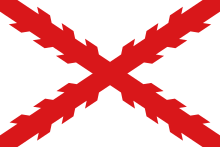Spanish Empire
Appearance

The Spanish Empire, sometimes referred to as the Hispanic Monarchy or the Catholic Monarchy, was a colonial empire that existed between 1492 and 1976. In conjunction with the Portuguese Empire, it ushered in the European Age of Discovery. It achieved a global scale, controlling vast portions of the Americas, Africa, various islands in Asia and Oceania, as well as territory in other parts of Europe. It was one of the most powerful empires of the early modern period, becoming known as "the empire on which the sun never sets". At its greatest extent in the late 1700s and early 1800s, the Spanish Empire covered over 13 million square kilometres (5 million square miles), making it one of the largest empires in history.
Quotes
[edit]- Pride, the First Peer, and President of Hell,
To his share Spain, the largest province, fell.
The subtile prince thought fittest to bestow
On these the golden mines of Mexico,
With all the silver mountains of Peru,
Wealth which would in wise hands the world undo,
Because he knew their genius was such,
Too lazy and too haughty to be rich,
So proud a people, so above their fate,
That if reduced to beg, they’ll beg in state,
Lavish of money, to be counted brave,
And proudly starve, because they scorn to save.
Never was nation in the world before
So very rich, and yet so very poor.- Daniel Defoe, The True-born Englishman (1701)

